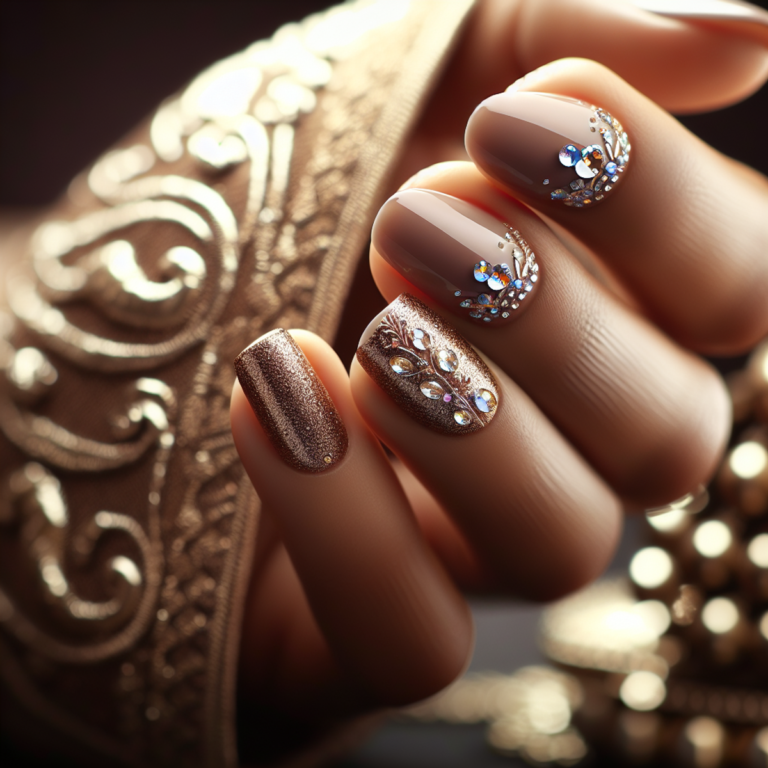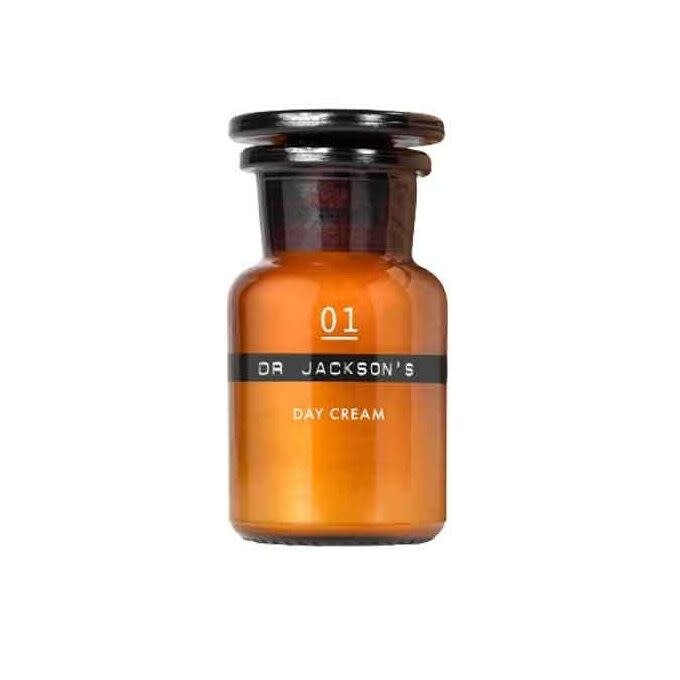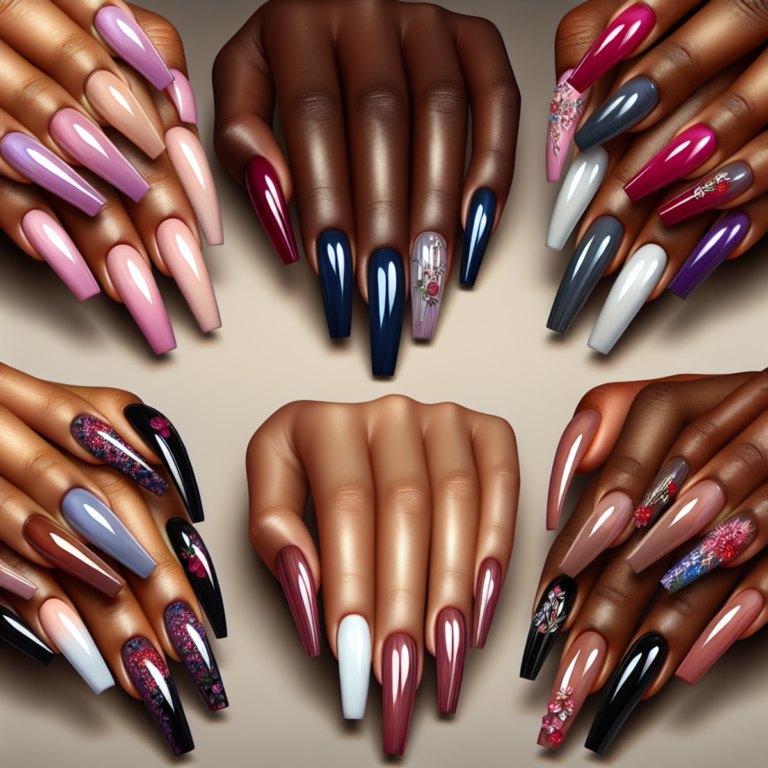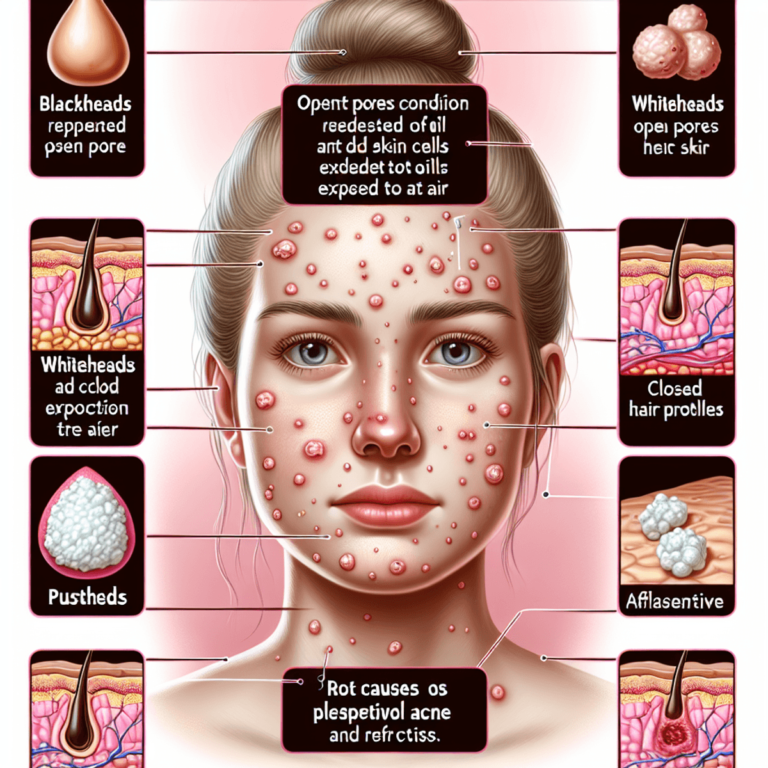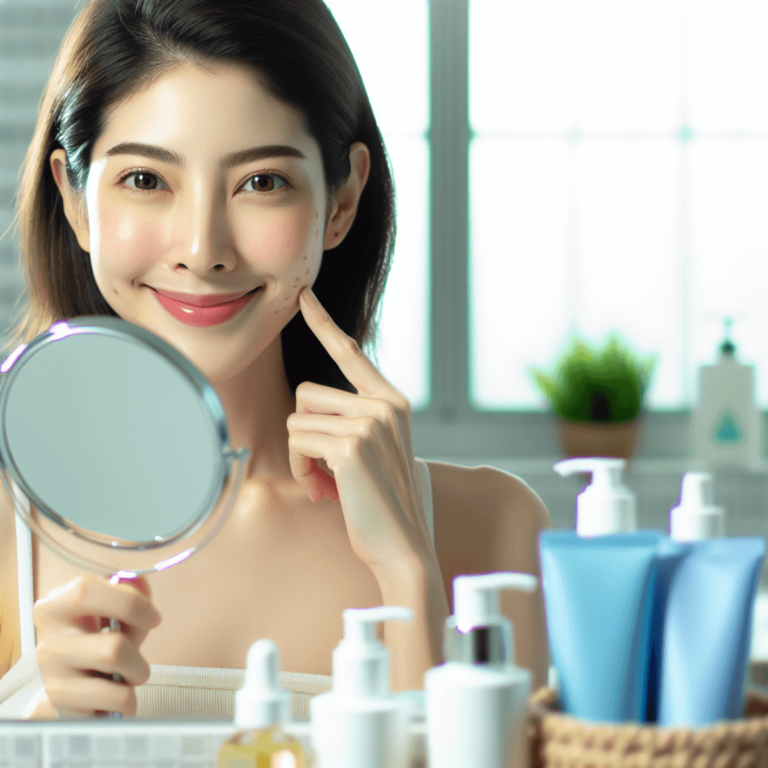How to Get Rid of Pimples & Acne Fast
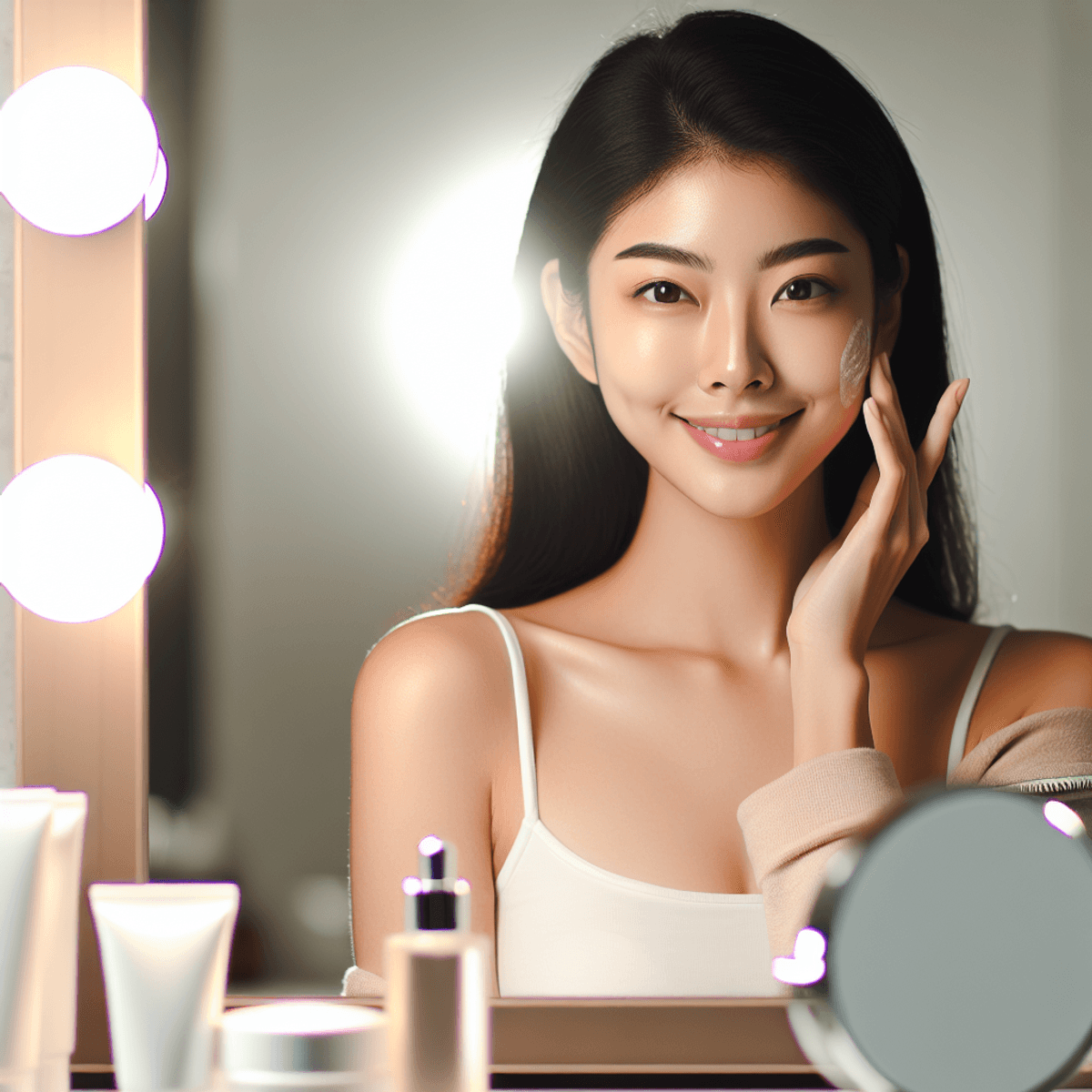
Introduction
Dealing with pimples and acne can be frustrating, especially when you need a fast solution. This article provides comprehensive strategies on how to get rid of pimples & acne fast, using both quick remedies and long-term solutions. Whether you’re looking for immediate relief or seeking ways to prevent future breakouts, this guide covers everything from topical treatments to lifestyle changes.
Pimples and acne are common skin issues that can affect your confidence and daily life. The urgency in addressing these problems effectively cannot be overstated. Swift action can prevent further inflammation, reduce pain, and minimize the risk of scarring.
In this article, you will find:
- Detailed explanations of the causes of pimples and acne.
- Quick remedies such as benzoyl peroxide, salicylic acid, and tea tree oil.
- Home remedies like ice application and crushed aspirin paste.
- Professional treatments for severe cases, including cortisone injections and blue light therapy.
- Natural methods to remove pimples permanently through lifestyle changes and proper skincare routines.
- Preventive measures to avoid future breakouts.
By the end of this guide, you’ll have a clear understanding of how to tackle pimples rapidly and maintain healthy skin in the long run.
Understanding Pimples and Acne
Acne is a common skin condition that affects millions of people worldwide. It can be distressing because it impacts our appearance and self-esteem. But don’t worry, understanding the causes and types of pimples can help you tackle this issue more effectively.
Common Causes of Acne
1. Hormonal Changes
Hormonal fluctuations, especially during puberty, menstruation, pregnancy, or menopause, can lead to increased oil production in the skin. These changes stimulate the sebaceous glands to produce more sebum, which can clog pores.
2. Clogged Pores
Dead skin cells and excess oil are primary culprits in pore blockage. When these elements combine, they create an environment where pimples can form.
3. Bacterial Growth
The bacterium Propionibacterium acnes thrives in clogged pores. This bacteria exacerbates inflammation and leads to more severe acne formations.
4. Inflammation
Inflammatory responses from your body can turn minor blockages into painful acne lesions. Swelling, redness, and discomfort are common symptoms associated with inflamed acne.
Types of Pimples
Acne comes in different forms, each needing its own treatment:
- Whiteheads: These are closed comedones where the pore is clogged but remains under the skin’s surface. They appear as small white bumps.
- Blackheads: Open comedones that occur when a pore is clogged but remains open at the surface, allowing the trapped material to oxidize and turn black.
- Papules: Small red or pink bumps that are inflamed but do not contain pus. They can be tender to touch.
- Pustules: Similar to papules but with a white or yellow center filled with pus. These are typically more painful and noticeable than papules.
- Nodules: Large, solid lumps beneath the skin’s surface caused by severe inflammation and infection deep within the pore. They are often painful and harder to treat with over-the-counter medications.
- Cysts: The most severe form of acne lesion. Cysts are large, pus-filled lumps beneath the skin’s surface that can be very painful and may cause scarring if not treated properly.
Knowing these types helps you figure out what kind of acne you have so you can pick the right treatments for faster relief.
Understanding both the causes and types of acne is key for effective management and prevention strategies that will be discussed later on. For a deeper insight into this prevalent condition, it’s beneficial to explore resources like this one from NIAMS, which offers a comprehensive overview of acne including its causes, symptoms, diagnosis, and treatment options.
Quick Remedies to Get Rid of Pimples Fast
Topical Treatments for Quick Relief
Effectively addressing pimples and acne requires targeted topical treatments. The following options are renowned for their efficacy in providing fast acne treatment:
Benzoyl Peroxide: Mechanism and Application Tips
Benzoyl Peroxide is a powerful ingredient used in many over-the-counter acne treatments. It works by:
- Killing Acne-Causing Bacteria: Benzoyl peroxide penetrates the pores to eliminate bacteria, reducing inflammation and preventing future breakouts.
- Exfoliating Dead Skin Cells: It helps remove dead skin cells that clog pores, ensuring clearer skin.
Application Tips:
- Start with a lower concentration (2.5% to 5%) to minimize skin irritation.
- Apply a thin layer to the affected area once or twice daily.
- Always use sunscreen during the day, as benzoyl peroxide can increase sun sensitivity.
Salicylic Acid: Benefits for Unclogging Pores Quickly
Salicylic Acid, a beta hydroxy acid (BHA), is another effective solution for how to get rid of pimples:
- Penetrates Deep into Pores: Salicylic acid dissolves excess oil and exfoliates dead skin cells inside the pores, helping to quickly clear blockages.
- Reduces Inflammation: Its anti-inflammatory properties soothe irritated skin and reduce redness.
Usage Guidelines:
- Look for products with 0.5% to 2% salicylic acid.
- Use a salicylic acid cleanser or spot treatment once or twice daily.
- Avoid combining with other strong acids or retinoids to prevent irritation.
Tea Tree Oil: Antibacterial Properties and Usage Guidelines
For those seeking natural remedies, Tea Tree Oil offers potent antibacterial benefits that aid in how to get rid of breakouts:
- Antibacterial Action: Tea tree oil kills acne-causing bacteria, reducing the risk of infection and promoting faster healing.
- Anti-inflammatory Effects: It helps diminish swelling and redness associated with pimples.
Application Tips:
- Dilute tea tree oil with a carrier oil (e.g., jojoba oil) to avoid skin irritation.
- Apply the diluted mixture using a cotton swab directly onto the pimple once or twice daily.
- Perform a patch test before full application to check for allergic reactions.
These topical treatments provide effective solutions for how to get rid of pimples overnight and achieve quick relief from acne. Their specific mechanisms offer targeted action against common causes of acne, ensuring you can manage breakouts efficiently.
Home Remedies for Instant Pimple Solutions
When you need fast acne treatment, home remedies can offer quick relief. These methods are particularly useful for urgent breakouts when you need to know how to get rid of pimples overnight.
Ice Application
Applying ice is a simple yet effective way to reduce swelling and inflammation rapidly. Here’s how it works:
- Mechanism: Ice constricts blood vessels, which helps decrease the redness and swelling associated with pimples.
- How to Use:
- Wrap an ice cube in a clean cloth.
- Apply it to the affected area for about 5 minutes.
- Remove for another 5 minutes and repeat as needed.
This method provides immediate relief from pain and redness, helping you address how to get rid of breakouts quickly.
Crushed Aspirin Paste
Aspirin contains salicylic acid, making it a potent DIY remedy for fast acne treatment.
- Mechanism: The anti-inflammatory properties of aspirin help reduce the size and redness of pimples.
- How to Use:
- Crush one or two aspirin tablets.
- Mix the powder with a few drops of water to form a paste.
- Apply the paste directly onto the pimple and leave it on for about 10-15 minutes before rinsing off.
Using this technique addresses how do you get rid of pimples effectively at home.
Hydrocortisone Cream
Hydrocortisone cream can provide immediate relief by reducing inflammation. However, it’s crucial to use it safely.
- Mechanism: Hydrocortisone is a corticosteroid that minimizes swelling and redness.
- How to Use:
- Apply a small amount directly onto the pimple.
- Use sparingly to avoid thinning the skin or causing other side effects.
This cream is particularly useful for those wondering how to get rid of pimples on face quickly without resorting to more invasive treatments like cortisone injections.
Incorporating these home remedies into your skincare routine can provide speedy solutions when you’re pressed for time. Each method offers unique benefits, allowing you to choose the best approach depending on your specific needs.
Professional Treatments for Severe Cases
Cortisone Injections: A Quick Fix for Deep Pimples
Cortisone injections are a highly effective solution for treating severe acne, particularly inflamed cystic lesions. These injections are performed by dermatologists and can provide almost immediate relief from painful, swollen pimples.
How Cortisone Injections Work:
- Targeted Treatment: The injection delivers a corticosteroid directly into the cystic pimple. This targeted approach ensures that the medication acts precisely where it’s needed.
- Reducing Inflammation: Corticosteroids are potent anti-inflammatory agents. When injected, they quickly reduce the inflammation and swelling associated with deep pimples.
- Rapid Results: One of the main benefits of cortisone injections is the speed at which they work. Many patients notice a significant reduction in the size and pain of their pimples within 24 to 48 hours.
- Minimizing Scarring: By reducing inflammation swiftly, cortisone injections can help decrease the likelihood of scarring, which is often a concern with cystic acne.
Procedure:
- Consultation: A dermatologist will evaluate your acne to determine if you’re a suitable candidate for cortisone injections.
- Preparation: The area around the pimple is cleaned thoroughly to prevent infection.
- Injection: Using a fine needle, the dermatologist injects a small amount of corticosteroid directly into the pimple.
Safety and Considerations:
- Professional Administration Only: It’s crucial that these injections are administered by a qualified dermatologist to avoid potential side effects such as skin thinning or discoloration. For example, steroid injections have been known to cause such effects if not properly managed.
- Not for Frequent Use: While effective, cortisone injections should not be used frequently due to potential risks like skin atrophy. They are best reserved for occasional severe breakouts.
Cortisone injections offer a reliable option for those struggling with severe acne who need fast results. This treatment provides rapid relief from painful, inflamed cysts and helps minimize long-term scarring. Always consult with a dermatologist to ensure this method is appropriate for your specific needs.
Blue Light Therapy: Targeting Acne at Its Source
Blue Light Therapy is a non-invasive dermatological treatment that effectively targets acne-causing bacteria. Using specific wavelengths of blue light, this therapy penetrates the skin’s surface to reach the sebaceous glands, where Propionibacterium acnes (the bacteria responsible for acne) thrive. By disrupting the bacterial cell structures, blue light therapy significantly reduces bacterial colonies, leading to fewer breakouts.
Key Benefits of Blue Light Therapy:
- Non-Invasive: Unlike cortisone injections or more aggressive treatments, blue light therapy doesn’t require any needles or incisions. This makes it a comfortable option for those seeking professional help.
- Reduces Inflammation: Blue light not only kills bacteria but also reduces inflammation, helping to calm existing pimples and prevent new ones from forming.
- Minimal Side Effects: This therapy typically comes with minimal side effects compared to topical treatments that can sometimes cause dryness or irritation.
How It Works:
- Preparation: Prior to treatment, your dermatologist will cleanse your skin to remove any makeup or oils.
- Application: A specialized device emits blue light onto the affected areas. The session usually lasts about 15-30 minutes.
- Post-Treatment Care: There is no downtime required; you can resume your daily activities immediately after the session.
Why Consider Professional Help?
When home remedies like tea tree oil or ice application fall short, seeking professional treatments such as blue light therapy can be highly effective. Dermatologists can offer tailored solutions based on your specific skin type and severity of acne, ensuring you get the best possible outcome.
By addressing the root causes of acne and providing quick relief from inflammation, blue light therapy is an excellent option for those looking to clear their skin effectively and safely.
Natural Methods to Remove Pimples Permanently
Lifestyle Changes for Healthy Skin in the Long Run
Effective natural acne remedies often start with lifestyle changes that promote overall skin health. To minimize future breakouts and achieve long-term pimple solutions, consider incorporating the following adjustments:
Dietary Adjustments to Reduce Breakouts
Certain foods can trigger acne by increasing inflammation and oil production. Modifying your diet can significantly impact your skin’s appearance.
- Avoid Dairy Products: Dairy is known to influence hormone levels, which can make acne worse. Consider swapping cow’s milk for plant-based alternatives like almond or oat milk.
- Reduce Sugar Intake: High sugar levels spike insulin, leading to increased oil production and clogged pores. Opt for natural sweeteners or reduce your overall sugar consumption.
- Incorporate Omega-3 Fatty Acids: Foods rich in omega-3s like salmon, flaxseeds, and walnuts help reduce inflammation, potentially decreasing acne severity.
- Increase Antioxidant-Rich Foods: Fruits and vegetables high in antioxidants, such as berries, spinach, and kale, can combat oxidative stress and support clearer skin.
Importance of Hydration for Skin Health
Proper hydration plays a crucial role in maintaining balanced skin. Drinking adequate water helps flush out toxins that can lead to breakouts.
- Aim for at Least 8 Glasses of Water Daily: Staying well-hydrated keeps your skin moisturized from within, reducing dryness and excess oil production.
- Include Hydrating Foods: Cucumbers, watermelon, and oranges are not only hydrating but also provide essential vitamins that support skin health.
- Limit Caffeinated Beverages: Excess caffeine can dehydrate the skin. If you enjoy coffee or tea, balance it with extra water intake.
These dietary adjustments and hydration tips form a foundation for naturally removing pimples permanently. Consistency is key; these changes might not provide instant results but contribute significantly to long-term skin health.
Skincare Routine Essentials for Acne-Prone Individuals
A proper skincare routine complements dietary changes by ensuring your skin remains clear of impurities that cause breakouts.
Effective Exfoliation Techniques
Exfoliating helps remove dead skin cells that clog pores but should be done gently to avoid irritation.
- Use Chemical Exfoliants Over Physical Scrubs: Products containing AHAs (alpha hydroxy acids) or BHAs (beta hydroxy acids) dissolve dead skin cells without the harshness of physical scrubs.
- Limit Exfoliation Frequency: For sensitive or acne-prone skin, exfoliating 1-2 times per week is sufficient to prevent over-irritation.
Makeup Product Recommendations
Choosing the right makeup products is essential for those prone to acne.
- Opt for Non-Comedogenic Makeup: These products are specifically formulated to avoid clogging pores. Look for labels indicating “non-comedogenic” or “oil-free.”
- Ensure Thorough Makeup Removal: Always remove makeup before bed using a gentle cleanser to prevent buildup that could lead to breakouts.
Incorporating these practices into your daily routine promotes clear skin all year round. Understanding how diet and hydration impact your complexion provides a holistic approach to managing acne naturally.
Skincare Routine Essentials for Acne-Prone Individuals
Maintaining a consistent skincare routine is crucial for managing acne. Effective exfoliation techniques and non-comedogenic makeup options play important roles in keeping your skin clear and healthy.
Effective Exfoliation Techniques
Exfoliation helps remove dead skin cells that can clog pores and lead to breakouts. Here are some gentle methods:
- Chemical Exfoliants: Use products containing alpha hydroxy acids (AHAs) or beta hydroxy acids (BHAs). These acids dissolve dead skin cells without the need for scrubbing, reducing the risk of irritation.
- Enzyme Exfoliants: Derived from fruits like papaya or pineapple, these exfoliants break down dead skin cells naturally. They are typically less abrasive than physical exfoliants.
- Gentle Scrubs: If you prefer physical exfoliation, choose a scrub with fine, round particles to avoid micro-tears on the skin. Look for ingredients like jojoba beads or rice bran.
Non-Comedogenic Makeup Options
Choosing makeup formulated without pore-clogging ingredients is essential for acne-prone skin:
- Foundation: Opt for liquid or powder foundations labeled as non-comedogenic. Brands like Neutrogena SkinClearing Makeup or Clinique Acne Solutions Liquid Makeup offer good options.
- Concealer: Look for lightweight concealers that provide coverage without blocking pores. Products such as NARS Radiant Creamy Concealer are designed to be gentle on acne-prone skin.
- Blush and Bronzer: Stick to powder formulations rather than creamy ones, as powders are less likely to clog pores. Brands like BareMinerals Original Loose Powder Blush are recommended.
Implementing these tips into your daily skincare routine can help manage acne effectively while promoting overall skin health.
Preventive Measures to Avoid Breakouts in the Future
Daily Habits That Promote Clear Skin All Year Round
Preventing acne requires consistent habits that promote healthy skin. One crucial aspect is resisting the urge to pick at blemishes.
Why You Should Resist Picking at Pimples:
- Increased Inflammation: Picking can worsen inflammation, leading to more noticeable redness and swelling.
- Risk of Scarring: Manipulating pimples often results in scars that can be difficult to treat.
- Potential for Infection: Hands carry bacteria that can infect open blemishes, exacerbating acne issues.
Understanding the importance of not picking at your skin will help you maintain a clearer complexion.
Personalized Cleansing Routines Based on Skin Type:
Tailoring your cleansing routine to your specific skin type ensures you address its unique needs effectively. Here are some recommendations based on various skin types, inspired by the best skincare routines:
1. Oily Skin:
- Use a foaming or gel-based cleanser designed to remove excess oil without stripping moisture.
- Look for products containing salicylic acid or benzoyl peroxide to help control oil and prevent breakouts.
- Cleanse twice daily—morning and night—to keep oil production in check.
2. Dry Skin:
- Opt for a hydrating cream or lotion cleanser that adds moisture while cleaning.
- Ingredients like hyaluronic acid and ceramides are beneficial for maintaining hydration.
- Gentle cleansing once a day, preferably at night, can prevent over-drying.
3. Combination Skin:
- A balanced approach is key; use a gentle cleanser that addresses both oily and dry areas.
- Focus on ingredients like niacinamide which helps regulate oil production while soothing dry patches.
- Cleansing twice daily with lukewarm water can help manage different zones effectively.
4. Sensitive Skin:
- Choose fragrance-free, hypoallergenic cleansers to minimize irritation.
- Ingredients such as aloe vera and chamomile soothe sensitive skin while cleansing.
- Cleanse once daily with cool water to avoid triggering sensitivities.
5. Normal Skin:
- Maintain balance with a mild, non-comedogenic cleanser.
- Regular ingredients like glycerin and vitamin E support overall skin health.
- Twice-daily cleansing keeps the skin fresh without disrupting its natural state.
Implementing these personalized routines will help manage your specific skin concerns effectively while preventing future breakouts.
By adopting these preventive measures and understanding their impact on your skin’s health, you set the foundation for clearer, healthier skin year-round.
Product Choices That Help Prevent Acne Before It Starts
Preventing acne requires a proactive approach to skincare. Choosing oil-free products is essential in an anti-acne routine because these products do not contribute to clogged pores, which can trigger breakouts.
Key Ingredients to Avoid
Understanding which components worsen acne is essential:
- Heavy Creams with Occlusive Properties: These can trap moisture and bacteria, leading to blocked pores and potential flare-ups.
- Alcohol-based Products: While they might seem beneficial for drying out pimples, they can strip the skin of its natural oils, causing it to overcompensate by producing more oil.
- Fragrances and Dyes: Often irritate sensitive skin and can contribute to inflammation and breakouts.
Essential Product Types for Preventing Acne
- Non-comedogenic Moisturizers: These are designed not to clog pores. Look for labels that specifically mention “non-comedogenic.”
- Gentle Cleansers: Regular cleansing routines tailored to your skin type help keep the skin free from excess oil and dirt without causing irritation.
- Oil-Free Sunscreens: Protecting your skin from UV damage without adding extra oil is vital.
Using non-oil-based products is important because they help maintain a healthy balance of moisture without contributing to pore congestion. This strategy minimizes the risk of recurring pimples and acne flare-ups.
Tips for Choosing the Right Skincare Products
- Read Labels Carefully: Ensure that products are labeled as non-comedogenic or oil-free.
- Patch Test New Products: Test new skincare items on a small area of your skin before full application to avoid potential reactions.
- Consult a Dermatologist: For personalized recommendations based on your specific skin type and concerns.
Adopting these proactive strategies helps create an environment less conducive to acne development, promoting clearer, healthier skin.
Conclusion
Addressing pimples and acne promptly can drastically improve your skin’s appearance and boost your confidence. If you find that over-the-counter treatments and home remedies aren’t providing the desired results, seeking professional help is a wise step. Dermatologists can offer personalized treatments tailored to your specific skin needs.
A consistent skincare routine plays a crucial role in preventing future breakouts. Regular cleansing, exfoliating, and moisturizing keep your skin balanced and less prone to acne. Opt for non-comedogenic products to ensure your pores remain unclogged.
Your experiences with different methods are invaluable. We encourage you to share what has worked best for you in the comments below. Your insights could help others in their journey to clearer skin.
Stay proactive about your skincare, and always be open to trying new methods that could work better for you.
Final thoughts on pimple removal: consistency and the right approach can make all the difference. Whether it’s through quick remedies or long-term lifestyle changes, there are effective ways on how to get rid of pimples & acne fast.
FAQs (Frequently Asked Questions)
What are the common causes of pimples and acne?
Common causes of acne include hormonal changes, clogged pores due to dead skin cells and excess oil, bacterial growth, and inflammation.
What are some fast remedies to get rid of pimples overnight?
Fast remedies for pimples include using Benzoyl Peroxide, Salicylic Acid, or Tea Tree Oil. Additionally, home remedies like ice application, crushed aspirin paste, and hydrocortisone cream can provide immediate relief.
How do cortisone injections help with severe acne?
Cortisone injections work by flattening inflamed cystic acne lesions swiftly. They are particularly effective for deep pimples that do not respond well to topical treatments.
What lifestyle changes can help prevent future breakouts?
To minimize future breakouts, consider dietary adjustments such as avoiding dairy or sugar and ensure proper hydration for skin health. Establishing a consistent skincare routine is also essential.
What should I avoid doing when I have pimples?
It’s important to resist the urge to pick or pop pimples as this can worsen inflammation. Additionally, follow a regular cleansing routine tailored to your skin type to promote clear skin.
How can I maintain clear skin in the long run?
Maintaining clear skin involves using non-comedogenic makeup products, gentle exfoliation practices, and being mindful of ingredients in skincare products that may exacerbate acne.


